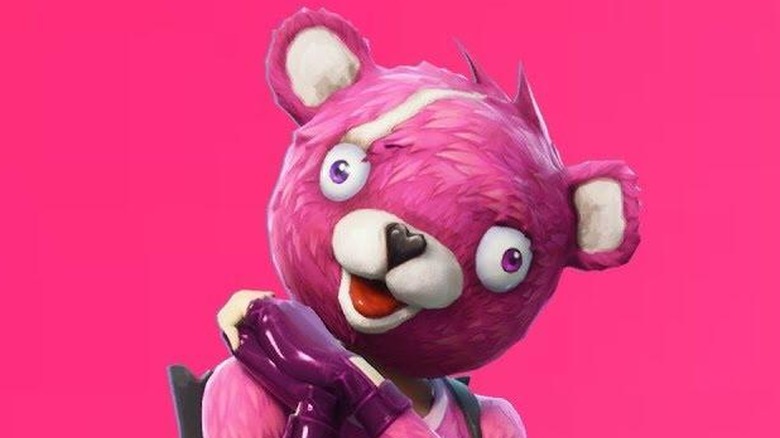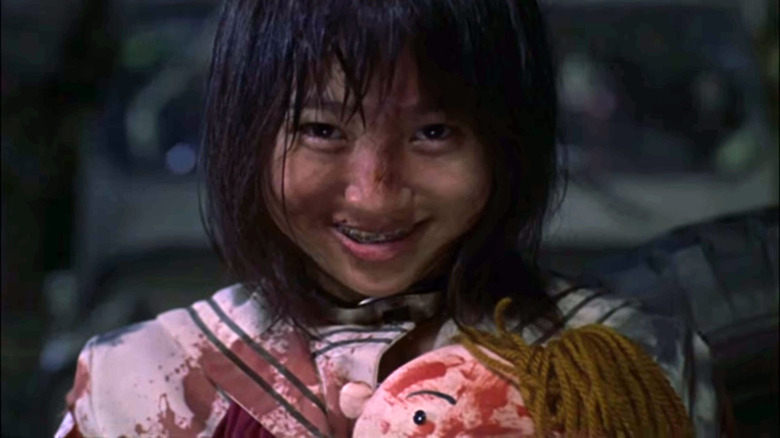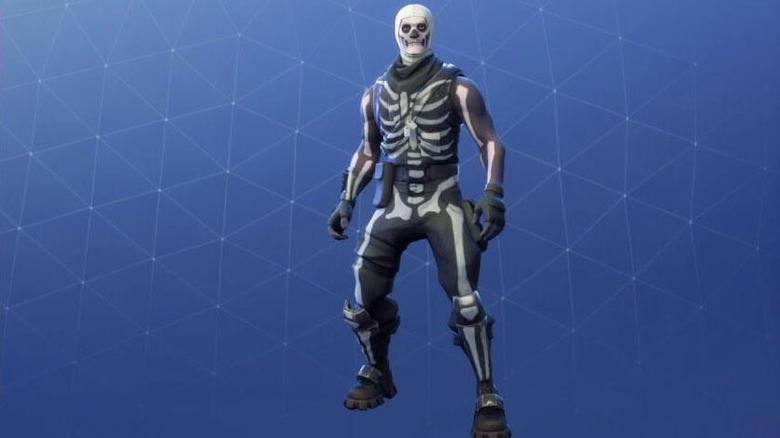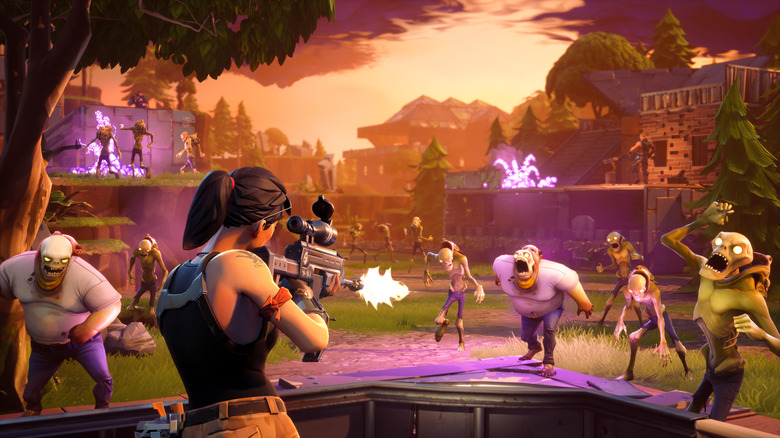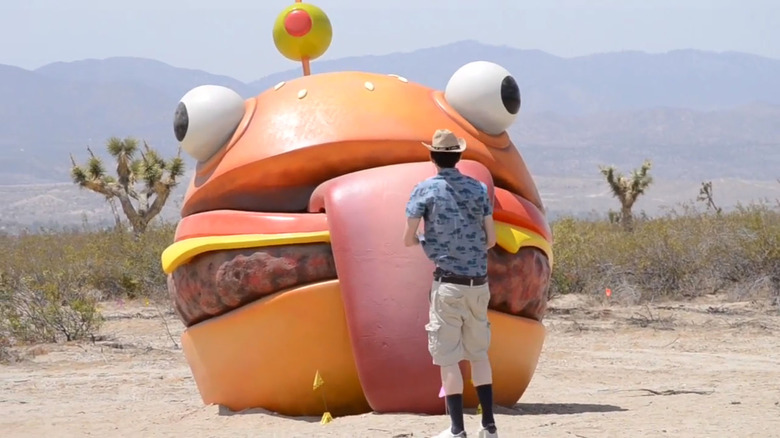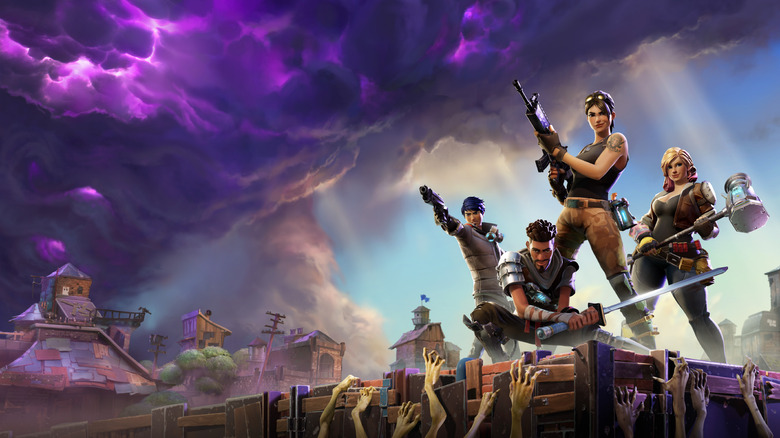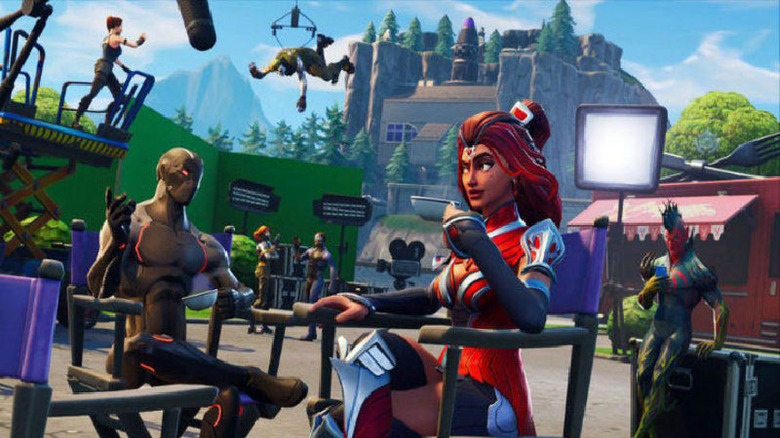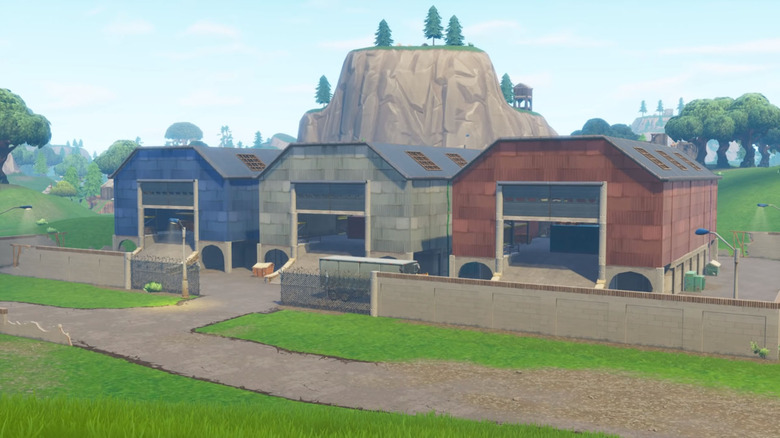Weird Things Everyone Just Ignores About Fortnite
Flying buses, pinatas filled with weapons, ancient temples dedicated to fast food mascots, and a sky that's been busted wide open? Yeah, even for a video game, Fortnite is pretty darn weird. It's also the hottest title in years, and it's getting attention from the press to match. In other words, if there's something odd happening in Fortnite, you've probably heard about it.
Or have you? There are so many bizarre things happening in Fortnite at any given moment that some of them inevitably fall through the cracks. They shouldn't. Some of the most interesting, strange, and flat-out unsettling aspects of Fortnite are the ones that almost nobody seems to be talking about. Let's change that. These may not be the Fortnite mysteries that you'll see in the headlines, but they warrant further investigation just the same. At the very least, they don't deserve to be ignored entirely.
Making child-murder child-friendly!
If you haven't heard, Fortnite: Battle Royale is big with the young folks. In class, if kids aren't playing Fortnite on their phones, they're watching Fortnite videos or talking about the game on social media. It's easy to see why. Fortnite is mobile-friendly, it's funny and colorful, and it's free. As one teacher puts it, that's "the perfect concoction of addiction."
Here's the thing, though: Fortnite's popularity in schools isn't just making life hard for educators. It's supremely messed up. See, that "battle royale" in Fortnite: Battle Royale isn't just a snappy subtitle. It's a direct reference to the ultra-violent Japanese thriller Battle Royale. In the 2000 film, the Japanese government decides to crack down on juvenile delinquency by sending classes of ninth graders to a deserted island, assigning the kids random weapons, and giving them three days to murder all of their classmates. Yikes.
Battle Royale follows one particular group of students on their three-day slaughterfest, and yeah, it's just as gory and disturbing as it sounds. It was also a major influence on Brendan "PlayerUnknown" Greene, who named the mods he made for DayZ and H1Z1 after the movie, inadvertently christening the entire genre. Greene went on to make PlayerUnknown's Battlegrounds, then Epic liked PUBG so much that they ripped it off, and now we've got classrooms full of kids obsessed with a game that's predicated on murdering classrooms full of kids. Yeah. That just ain't right.
Those characters don't belong to you
You don't just play Fortnite to score a Victory Royale. If you're a real fan, you also log in every week — or, more likely, every day — to complete Fortnite's Battle Pass challenges, which unlock all kinds of fun bonuses, including cosmetic upgrades known as skins. Skins, many of which can also be bought using real money, don't give players much more than bragging rights, but they do help make Fortnite more personal and a lot more fun.
Some of those Fortnite skins look awfully familiar, though. Like, way too familiar. We're not just talking about the Reaper skin, either, which looks so much like Keanu Reeves' puppy-deprived gunslinger John Wick that most people just refer to it as John Wick. Fortnite: Battle Royale's skin line-up is chock full of knock-off designs and nobody seems to care — not even the copyright holders.
For example, it might've been a while since you've seen the movie, but Fortnite's Skull Trooper skin is a one-to-one match for the skeleton Halloween costumes in The Karate Kid. Codename E.L.F is just Will Ferrell's costume from Elf with a couple of extra belts. With his mask down, Carbide is basically a color-swapped Iron Man, Rust Lord is an obvious Star-Lord "homage," and Omega gives off some serious Black Panther vibes, but Marvel doesn't just seem okay with some minor copyright infringement: the company actually put Thanos himself in the game. Go figure.
A mess six years in the making
Did you know that Fortnite is much, much bigger than just Battle Royale? You're forgiven if you've never heard about Fortnite's cooperative mode, Save the World. While Save the World launched via early access in summer 2017, it's the free-to-play Battle Royale that's making all of the headlines, rendering the player-versus-environment game an afterthought.
A very expensive and time-consuming afterthought, that is. It's not weird that one mode is more popular than the other: while Battle Royale is free, early access to Save the World costs $40, and besides, Battle Royale is where all the good mysteries are at. What's weird is how underbaked Save the World feels. It took six years for Fortnite: Save the World to make its way into players' hands and it's still not that interesting. Unlike Battle Royale, which is pretty simple at its core, Save the World is filled with fiddly but important systems that the game never bothers to explain. It's grindy and slow-paced, and it doesn't take long for Save the World to lose its luster.
That's the game that Epic has spent over half a decade making. By contrast, Battle Royale took a mere two months to put together (although, to be fair, Save the World had already laid the foundation), and was created largely on a whim. Save the World's shoddy state should be a major source of confusion. Fortunately, everyone's too busy playing Battle Royale to pay any attention.
The most ambitious crossover event in history
Back in June 2018, it looked like Fortnite: Battle Royale's storyline was going fully meta. After a mysterious figure launched a rocket into the air, the game's sky burst open and strange rifts appeared all over the map. As it turns out, those rifts weren't just scenery. As Fortnite's fourth season progressed, the rifts started consuming parts of the map, changing the landscape forever.
But where did Fortnite's lost landmarks go? As fans soon discovered, they were headed into the real world. A traveler found the Durr Burger sign, one of the map's highest profile casualties, resting in the California desert. Fortnite fans flocked to the location, where some of them were greeted by mysterious agents who handed out phone numbers. Those numbers led to a new code, which in turn helped fans locate some Fortnite supply llamas that somehow made their way out of Battle Royale and into real-life Europe.
It was all very weird and very, very cool, and for a few weeks the whole gaming internet seemed wrapped up in the mystery. Then Fortnite Season Five hit. In-game, the rifts turned out to have more to do with time travel than dimension hopping, a slow-moving cube captured everyone's attention, and the Durr Burger sign returned to Battle Royale only a little worse for wear. We still don't know what exactly happened, and chances are, we never will — at this point, the whole thing has been long forgotten.
All in good fun
If you've played a competitive shooter online any time in the past decade, you know how it goes. If your squad wins, some sore loser is going to yell at you. If your squad fails, well, expect pretty much the same thing.
Fortnite is different. Oh, sure, there are some salty Fortnite players out there — every community has its rough spots — but if you find yourself bracing for a non-stop torrent of profanity, whining, and hate speech, Fortnite is going to be a pleasant surprise. In Fortnite, experienced players take time to help out new ones. Instead of blaming each other for poor performance, it's pretty common to find Fortnite fans apologizing to each other after a game goes south. Heck, even Fortnite's de facto spokesperson, Tyler "Ninja" Blevins, is just as famous for being a decent person as he is for his sick Fortnite plays.
Nobody's really sure why the Fortnite community is so positive, either, although Ninja has a few thoughts. Blevins credits Fortnite: Battle Royale's low barrier to entry — it's free and available everywhere — for making the game seem friendly. That friendly carries over into the game and its players. Fortnite: Battle Royale's core gameplay loop might be focused on wiping out an island full of people, but between the rocket-surfing, the dance parties, and the treasure hunts, the game is full of other, non-competitive ways to waste time, keeping players busy and toxicity to a minimum.
The apocalypse that nobody noticed
In Fortnite's co-op mode — which, you'll remember, was originally supposed to be Fortnite's main attraction — the world has been decimated by mysterious purple clouds that decimated 98% of the world's population. As for the survivors, well, those same storm clouds also drop zombie-like creatures called husks that attack everyone as soon as it gets dark. In order to survive, the players must construct shelter when it's light, and then get ready to fend off the hordes once night falls.
It's not clear if Fortnite: Battle Royale takes place in the same world, although if it does it would explain a lot. Battle Royale's swirling purple storm — you know, the one that kills you if you don't move fast enough — seems awfully familiar to the one in Save the World. A post-apocalyptic setting explains why all of the houses, shops, and other various Battle Royale locations are empty and waiting for competitors to pick-axe their way in strip them of supplies and loot.
On the other hand, if Fortnite: Battle Royale does share a plotline with Save the World, then the game is a lot more sinister than it appears. Taking dead people's guns and using them to murder a bunch of other people is already morally suspect. If the human race is teetering on the edge of extinction, though, the entire battle royale concept goes from troubling to outright genocidal — and if it doesn't, well, where the heck did all the people go?
What a difference a story makes
We wouldn't even be asking these kinds of questions if Epic hadn't raised them. Back when Fortnite: Battle Royale was just a PUBG-inspired goof, it was easy to dismiss all of Fortnite's in-game weirdness. It didn't matter why a hundred people were boarding a flying school bus, parachuting onto an empty island, and slaughtering each other. It was just video games being video games.
Now, however, Fortnite: Battle Royale has a story. That means that things must happen for reasons. We don't know much about Fortnite's mysterious island or how it's become home to a never-ending battle to be the last man or woman standing, but we know that it's not a normal place. It's home to superheroes and supervillains. It's the center of a massive temporal disturbance. Frankly, it's all very LOST, and like that show, Fortnite demands answers. In fact, the addition of a plot calls Battle Royale's very nature into question. So far, however, people seem more interested in figuring out where that weird cube is going than looking for the real, more complicated truths.
It doesn't help that, as fun as it is, Fortnite: Battle Royale's story doesn't actually make a lot of sense. Plot threads don't add up, like the loading screens that imply that the whole superhero thing is a Hollywood fantasy even though the villain's rocket is clearly very real. Things happen, but it's all mystery, no answers, and events don't logically connect.
Gone, but not forgotten
Remember the first time that you discovered Dusty Depot's hulking weapon-filled warehouses? The first time that you waded into Moisty Mire, scouring the nearby cabins for loot? Stopping by the pastoral ranch at Anarchy Acres to take refuge in the farmhouse or crop fields?
Hold on to those memories, because at this point they're all you've got. Fortnite: Battle Royale is constantly changing, which is great for keeping players invested, but very bad news for any of you who want to play the same game that you fell in love with. Quite simply, you can't. These days, Dusty Depot is Dusty Divot. Moisty Mire now goes by Paradise Palms. Anarchy Acres has been razed to make room for Lazy Links. As Season Five transitions into Season Six and beyond, Fortnite is going to change even further. At this rate, in a year or three, there'll be nothing left of Fornite: Battle Royale's original map at all.
It's odd that, given Fornite's popularity, this isn't something that more people are concerned about. Fortnite: Battle Royale is the biggest and most influential game in the world right now. It's worth preserving for historical reasons alone. And yet, with every patch, we lose another piece of the game's past. Treasure those crazy kills you got with Fortnite's crossbows and jetpacks, people. They're already lost to time — and who knows what's going next?

